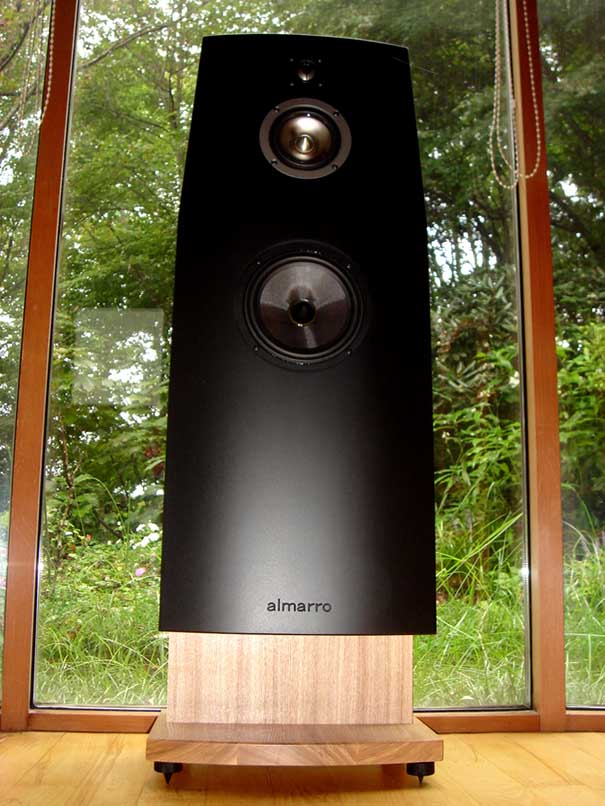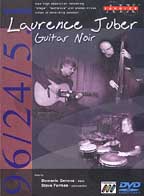Almarro M3A Loudspeakers
| Almarro M3A Loudspeakers |
| Does Almarro still have the magic? |
|
|
|
April 2007 |

A company that is still consumer driven
Last year, I had the pleasure of introducing you to the Almarro M2A loudspeakers. The M2As are a 2-way design with build quality and sound that are much more impressive that it’s $2,900 price point would suggest. So impressed was I with its sound that I still use the pair to do equipment evaluations. When Almarro’s chief operations manager, Yoshihiro Muramatsu, approached me about reviewing a new speaker they had just completed, the M3A, I was intrigued. They invited me to stop by their room at the 2006 CES and see if this was a speaker I would be interested in reviewing. I visited Almarro’s room to pay my respects and to give the M3A the once over and wound up being very impressed with what I was hearing. I felt that the M3As continued along Almarro’s path of providing a good quality speaker whose performance belied their price point. I told them I would be very much interested in writing a review of the speakers and arrangements were made. Several months later the speakers arrived and after a solid week of burn-in, I was ready to do the review.
Listening to the customer
I asked Yoshihiro Muramatsu to explain why Almarro decided to come out with the M3A, which at $2,700, is only $200 less in price than a pair of M2As. Yoshihiro prceeded to explain that Almarro is still very fond of the M2A (as am I), but wanted to build a speaker that would appeal to wider audience. Despite measurements to the contrary, Almarro received feedback from customers that the M2A’s performance at the frequency extremes was not quite as was hoped for. I encountered similar difficulty during my initial setup when I began my review of the M2As. I felt that the M2As needed to break-in almost twice as long as what was being recommended, and after that, had to experiment with placement and toe-in more than I had to with most speakers. Once I set them up to where I was happy with them, they sounded extremely good in my room. Yoshihiro said that Almarro decided they would come out with another speaker that would be more room friendly and have a smoother “in room” frequency response.
The build quality and craftsmanship of this speaker is first rate. The speaker itself stands 32” high and sits upon and integral stand that adds another 6” or so. This short stand is where you would insert 2 heavy-duty bolts that are about 8” long and 3/4” thick. The fit, as you could imagine, is very solid and tight. Nicely threaded spikes accompany the base and allow you to get a fairly rigid setup once you position the speakers to your liking. The M3As uses a 1.5” tweeter, 4” midrange and a 6” woofer, that are proprietary to Almarro. Connections on the M3As are made via Almarro’s custom made 5 way binding posts. The speakers weigh in at 62 pounds and were easy for me to move around in my room as I looked for the best place to situate them in my room. The M3As are finished in Japanese Tamo and painted black on the front and rear baffles. These speakers do not come with grill cloths.
So what did they sound like?
Finally, after I got them setup in my room I began to get into some serious listening. One of the things I liked about these speakers in my room was the ease with which I had setting them up. I got good performance whether I had them out into the room, closer to the rear walls or sidewalls. Most of my listening was done with the speakers 8 to 9 feet apart and about 7 feet from the rear wall. I never had any loss of focus or inconsistencies in my sound stage. The first thing I noticed was how smooth and musical the M3As are. When I did the review of the M2As, I had a much more difficult time finding a spot in my room where I felt they were suitable for listening and always had times where I felt the tweeter was a little aggressive or had a bit of a bite. It wasn’t until a good friend of mine suggested that I toe the M2As in to a point where there was an imaginary line coming from each tweeter that intersected a foot in front of my listening position. Once I did that, the M2As were magic. Well with the M3As, there was no such need to find the “sweet spot”. They were smooth and musical from the start, which I found to be a pleasant surprise after the experience with the M2As. The high frequencies performance of the M3A’s tweeter is smooth and tonally, slightly to the warm side of neutral. The highs could be very revealing and extended, but never aggressive. Cymbals and triangles had shimmer and sparkle. The midrange performance of the M3As was very good and on par with speakers that cost twice as much as they do. Male and female vocals were reproduced with immediacy and delicacy that you normally would not associate with a speaker at this price point. The bass performance was good, especially for a speaker of this size and at this price point. The M3A’s dynamic performance was lively and punchy. This speaker is in no ways laid back and will gain your attention. The M3As threw a nice stage in my 25′ X 15′ room. Image height was good as was the depth and stage width seemingly extended past the boundaries of my walls.
One disc I like to listen to, though it’s not their best effort, is the self titled album from Stan Getz and Bill Evans [Verve]. This disc is interesting in that you can actually hear Stan Getz and Bill Evans feeling each other out, looking for a common thread from which to build off of. But Elvin Jones really shines on this disc, especially on the track “Night and Day.”  The Almarro M3As actually let you hear all of this going on and does not muddy things up. Andy Bey’s CD American Song[Savoy Jazz] is one of my favorite discs because there is not a bad track on the entire disc. Every arrangement is done beautifully and the mic placement on Bey’s voice creates a sense of intimacy. The musical performances backing Mr. Bey support him with music that is worthy of being on an album all to itself. The M3As allow Mr. Bey to magically appear in your room with all of his vocal inflections, breathing, and mellifluous tones clearly present and easy to hear. Female vocals also are handled with aplomb. Jane Monheit’s disc, In the Sun [Warlock Records], produces one captivating track after another and the selections allow you to experience her wonderful voice. The M3As depict Ms. Monheit’s vocals as fresh and vibrant with a large amount of presence.
The Almarro M3As actually let you hear all of this going on and does not muddy things up. Andy Bey’s CD American Song[Savoy Jazz] is one of my favorite discs because there is not a bad track on the entire disc. Every arrangement is done beautifully and the mic placement on Bey’s voice creates a sense of intimacy. The musical performances backing Mr. Bey support him with music that is worthy of being on an album all to itself. The M3As allow Mr. Bey to magically appear in your room with all of his vocal inflections, breathing, and mellifluous tones clearly present and easy to hear. Female vocals also are handled with aplomb. Jane Monheit’s disc, In the Sun [Warlock Records], produces one captivating track after another and the selections allow you to experience her wonderful voice. The M3As depict Ms. Monheit’s vocals as fresh and vibrant with a large amount of presence.
 On the DVD-A disc of Laurence Juber’s, Guitar Noir [AIX Records] there is a wealth of detail and information on display. Mr. Juber’s finger work on the strings is excellent, as is the percussion by Steve Forman. The M3A’s drivers are fast and the transients are rendered with good snap and decay. On Wynton Marsalis’ The Magic Hour [Blue Note], Eric Lewis’ closely miked piano is clearly on display here as the M3As allow you hear the attack of the keys and decay after the hammer strikes the cords. With their imaging capabilities and neutral tonality, the M3As also do classical music very well. Benjamin Zander and the Philharmonia Orchestra’s performance of Mahler: Symphony No. 6 in A Minor, is portrayed as being performed in a spacious hall with voluminous passages with excellent timbre, detail and resolution.
On the DVD-A disc of Laurence Juber’s, Guitar Noir [AIX Records] there is a wealth of detail and information on display. Mr. Juber’s finger work on the strings is excellent, as is the percussion by Steve Forman. The M3A’s drivers are fast and the transients are rendered with good snap and decay. On Wynton Marsalis’ The Magic Hour [Blue Note], Eric Lewis’ closely miked piano is clearly on display here as the M3As allow you hear the attack of the keys and decay after the hammer strikes the cords. With their imaging capabilities and neutral tonality, the M3As also do classical music very well. Benjamin Zander and the Philharmonia Orchestra’s performance of Mahler: Symphony No. 6 in A Minor, is portrayed as being performed in a spacious hall with voluminous passages with excellent timbre, detail and resolution.
So, how does it compare?
I was curious to know why Yoshi Muramatsu would make two speakers that are so similarly priced, being only $200 difference between the M2A ($2,900) and the M3A ($2,700), and found the reasons, mentioned above, to be eerily similar to my findings. Here are what my observations are of the two Almarro speakers. The M2A, with it’s very revealing tweeter and high frequency performance requires more effort and setup to get the best out of. It’s a high effort/high reward type of experience. The M3A on the other hand is easier to setup and optimally place in your listening room. The M3A has very good high frequency performance. The upper ranges are sweeter with good ambiance retrieval. The upper frequencies played through the M2As were more detailed and airier. The M3A is the more musical speaker but the M2A draws you more into the musical experience and is slightly more detailed. Bass performance on both speakers is good and depends on what you like. The M3A’s bass performance is fuller and warmer, but not quite as tight as the M2A. The M2A’s bass performance, while being tighter, is also a tad bit deeper and has more bass detail. Where the M3A better the M2A is in the midrange and has a slight edge when it comes to vocals and acoustic guitar and bass.
If I had to choose between the M2A and M3A, I would take the rewards offered by putting in the time and effort to setup the M2As. The M3As also are an excellent speaker and a lot easier to get the best sound out of in the majority of rooms that you would find it in. The M3As sounded good with solid state and tube gear. They are not a hard load for tube amplifiers and seemed slightly easier to drive than the M2As. Tonally, as I said earlier, the speakers tend to be slightly on the warm side of neutral. When I used speaker cables and interconnects that are fairly detailed, such as the Klyne Dragonfly Wings and the Sunny Cable Technology, the speakers character became more detailed and the bass became tighter. Cables such as those from Mood Acoustics and DCCA Audio gave the sound more dimensionality and a warmer, natural sound. In terms of CD players, the Esoteric DV50S sounded good being played through the M3As, but the Accuphase DP-67, with it’s natural sounding midrange helped make the M3As performance closer to that of a $4-5K speaker.

In my opinion, the performance offered by these speakers in the $2,500 – 3,000 price point is remarkable and offer good value. If you are looking for speakers in this price range, I would strongly recommend you give the M3As a listen. These speakers are an early candidate to receive one of my “Most Wanted Components” for 2007.
Michael Wright
____________________
Specifications
Dimensions: 13.8” W x 38.2” H x 10.6” D
Weight: 62lbs /each
Drivers: Tweeter: 1.5”
Midrange: 4”
Woofer: 6”
Power Handling: 120 watts
Frequency Response 30Hz – 26kHz
Sensitivity: 88dB
Crossover: Woofer/Mid at 3000Hz
Mid/Tweeter at 2.5kHz
Price: $2,700
Manufacturer
Almarro Audio
USA Office
1800 Fumia Place
San Jose , CA 95131
Japan Office
3489-24 Kitagata Iida-shi Nagano 395-0151 Japan
Phone: +81 265 25 1082
Fax:+81 265 25 8250
http://www.almarro.com
![]()
Don’t forget to bookmark us! (CTRL-SHFT-D)
Stereo Times Masthead
Publisher/Founder
Clement Perry
Editor
Dave Thomas
Senior Editors
Frank Alles, Mike Girardi, Key Kim, Russell Lichter, Terry London, Moreno Mitchell, Paul Szabady, Bill Wells, Mike Wright, Stephen Yan, and Rob Dockery
Current Contributors
David Abramson, Tim Barrall, Dave Allison, Ron Cook, Lewis Dardick, Dan Secula, Don Shaulis, Greg Simmons, Eric Teh, Greg Voth, Richard Willie, Ed Van Winkle, and Rob Dockery
Music Reviewers:
Carlos Sanchez, John Jonczyk, John Sprung and Russell Lichter
Site Management Clement Perry
Ad Designer: Martin Perry





Be the first to comment on: Almarro M3A Loudspeakers